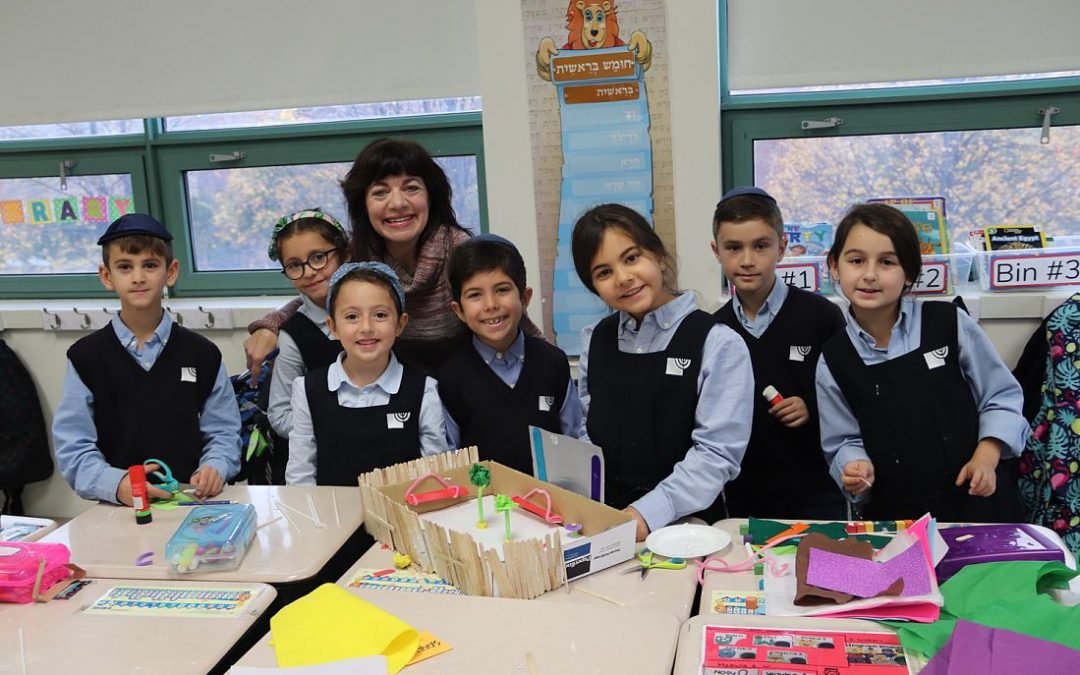It’s 11:30 am and the children are glued to the screen, waiting to see the results of the Final Quest on the Leaderboard. Cheers erupt from a corner of the room as the Superstars are declared the winners with a final score of 19 out of 20.
Sounds like a typical Sunday morning with teens gathered around the game console. Except it’s Monday, the kids are in Grade 2, and they’re glued to a Google Sheet on the Smart Board. The Final Quest is actually a class assignment, and the Superstars are one of five student-named teams that regularly compete against one another in friendly challenges created by their English teachers Mrs. Renee Pervin and Morah Elyse Haber. It’s all part of gamification in education and it’s taking Hebrew Academy by storm.
“Gamification uses game-like elements in the classroom which can be applied to any subject,” explained Mrs. Renee, who has been implementing gamification at HA for the last three years. “Gamification is an extension of what we’re already learning. I think some might wonder, ‘when do you get through the curriculum if you’re playing games and having fun?’ But it is the curriculum.”
Mrs. Renee first learned about gamification in an online workshop and was inspired by its potential to engage and motivate students, among other objectives. She followed up with a book and videos on the approach, then worked to implement it in her Grade 4 class with a coach from Better Lesson, an organization that mentors some HA teachers through a grant from the Avi Chai Foundation. Mrs. Renee ultimately became so skilful at implementing gamification in the classroom that she presented on the subject to fellow Better Lesson members this past June.
“Gamification allows students to collaborate and is great for student engagement and critical thinking,” she said. “It motivates students to become more involved and encourages them to be active participants in the classroom. Someone really quiet in class who doesn’t participate can shine in this kind of setting; maybe they are very creative or artistic or perhaps they feel more comfortable showing off their skills in a smaller group.”
In addition to promoting student engagement, another benefit of gamification is that it facilitates differentiation, an educational philosophy that recognizes that effective instruction cannot be one-size-fits-all. Differentiation aims to make learning more of an active, collaborative experience and promotes learning based on ability, interest or preferences, with the teacher serving as facilitator.
“With gamification, students choose which activity interests them and which they feel comfortable doing,” said Mrs. Renee. “The activities vary in level; some are tough, some are a bit less challenging. Everyone has something to choose from. I know it works when students who find everything easy look stumped. It’s the best feeling, because those are the kids who are hard to excite at times. I want learning to be fun for everyone.”
Before starting a unit, Mrs. Renee and Morah Elyse divide the class into teams. As they progress through the lessons, the teachers introduce Superquests, curriculum-based activities that students can tackle upon completion of class work. A Grade 2 student who finishes three Superquest activities, for example, will collect three additional points for his or her team. In Mrs. Renee and Ms. Arielle Magid’s Grade 4 English classes, students collect a letter for every Superquest they complete which ultimately leads to a mystery word.
“To add an extra layer to the Superquest, students must unscramble the letters they received to figure out the mystery word,” said Mrs. Renee. “Students have to work hard to get their points added to their Leaderboard!”
A Superquest activity might be a math or language arts activity about a concept the teachers wish to reinforce.
“If we’re working on different writing styles, one Superquest might be to write a friendly letter or poem about a character from a book,” said Mrs. Renee. “The idea is to make what you’re already learning in the classroom fun, engaging and motivating so students will want to do as much as they can. Superquests are super-popular!”
Once a week, the teachers lead a Friday Challenge, “a special activity that reinforces our learning, and it’s another way to earn your team points,” said Mrs. Renee.
Each Friday Challenge is unique. Students may have to answer Jeopardy questions, have a Task Card race or Scavenger Hunt, for example. After four or five Friday Challenges, teams are presented with the most exciting task: the Final Quest, a project that incorporates all of the concepts taught during the term.
“Elyse and I create a project that we think is meaningful to the kids, with a real-world element in a bigger setting, that emphasizes the skills they acquired. The teams were recently challenged to a construction project. There was a lot of anticipation around it.”
For Grade 2’s Final Quest in early November, teams were presented with a letter “composed” by CSL Mayor Mitchell Brownstein, asking them to help design a new playground surrounding trees in Trudeau Park. The mayor presented a list of requisite elements teams had to include in their model parks, and specified which materials to use in their arts and crafts construction.
“We’re reading Lisa Campbell Ernst books in class, and we just read Squirrel Park which has a similar theme,” said Mrs. Renee. “Elyse and I jumped off from there and used math concepts that we had worked on, such as repeating and growing patterns, and estimation.”
The results were fabulous: students divided the tasks independently and used their respective skills to create beautiful, vibrant mock-ups that reflected their strength as a unit. Teams were evaluated based on their efforts, creativity, respect for their peers and their abilities to follow directions, with one group emerging on top. The students are incredibly proud of their projects, and “may even invite Mayor Brownstein to come check them out. Maybe he’ll get some ideas!”
For Mrs. Renee and Morah Elyse, “the best part of gamification is all the layers. We are always thinking of new layers – ways to add more fun to the game. This year, we’ve introduced Sidequests, an extension of an in-class challenge that can be completed at home while providing an opportunity to learn more and gain team points. Also, to keep things exciting, once teams accrue a certain number of points, they receive a badge. Each badge entitles the teams to something extra; extra time or extra materials provided for their Final Quest. All these layers serve to keep up the game’s momentum and to bring teams closer together.”
Morah Elyse, who is also the Elementary Director of English Studies and Technology Integration, agrees: “Gamification is new for me this year and I’m thrilled with how much my students are enjoying it. Watching them work in teams, encouraging and helping each other, has been something really special. Gamification is happening in many of our grades this year and we are all grateful to Renee for bringing in this special program!”
Click here for more photos.
– by Aviva Engel, Director of Communications

